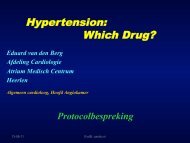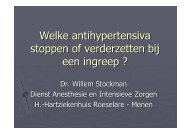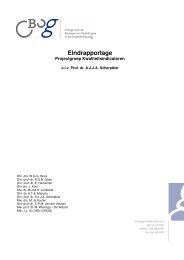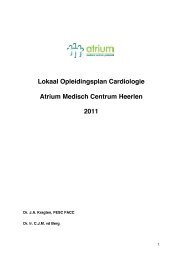Guidelines on the Management of Stable Angina Pectoris ... - Cardio
Guidelines on the Management of Stable Angina Pectoris ... - Cardio
Guidelines on the Management of Stable Angina Pectoris ... - Cardio
You also want an ePaper? Increase the reach of your titles
YUMPU automatically turns print PDFs into web optimized ePapers that Google loves.
32 ESC <str<strong>on</strong>g>Guidelines</str<strong>on</strong>g>24 h and a 17/8 mmHg difference during <strong>the</strong> night, comparedwith 8/2 mmHg with <strong>of</strong>fice measurements in <strong>the</strong>same study. 464 In EUROPA, patients with unc<strong>on</strong>trolled hypertensi<strong>on</strong>(.180/100 mmHg) were also excluded, and <strong>the</strong>mean blood pressure at baseline was 137/82 mmHg. Theoverall blood pressure difference between perindopril andplacebo treatment was 5/2 mmHg, 461 but larger differencesmay have occurred in subgroups <strong>of</strong> patients. However, analysis<strong>of</strong> <strong>the</strong> effect <strong>of</strong> treatment according to tertiles or quartiles<strong>of</strong> baseline blood pressure or fall in blood pressure <strong>on</strong>treatment shows significant benefit in all groups, eventhose in <strong>the</strong> lowest baseline blood pressure or smallestreducti<strong>on</strong> in blood pressure with treatment. 465 Benefits <strong>of</strong>blood pressure reducti<strong>on</strong>s may be expected in subgroups<strong>of</strong> patients with clearly elevated blood pressure, but loweringblood pressure is associated with a lowering <strong>of</strong> cardiovascularrisk also in <strong>the</strong> ‘normal’ range. 466 Thus, it is difficult toseparate blood pressure-related effects from bloodpressure-independent protecti<strong>on</strong> afforded by ACE-inhibiti<strong>on</strong>in stable angina pectoris.Fur<strong>the</strong>r clues regarding <strong>the</strong> effect <strong>of</strong> blood pressure loweringand ACE-inhibiti<strong>on</strong> in stable cor<strong>on</strong>ary disease may beobtained from <strong>the</strong> CAMELOT trial. 467 In this study, patientswith angiographic evidence <strong>of</strong> cor<strong>on</strong>ary disease, althoughnot necessarily obstructive, and normal blood pressure(mean BP 129/78 mmHg) were randomized to amlodipine,enalapril, or placebo and followed-up for 2 years. Sixtypercent <strong>of</strong> <strong>the</strong> patients had hypertensi<strong>on</strong> and <strong>the</strong>y werewell treated in o<strong>the</strong>r respects (83% <strong>on</strong> statins, 75% <strong>on</strong> a betablocker,and 95% <strong>on</strong> aspirin). Blood pressure reducti<strong>on</strong>s(5 mm/2 mm) were almost identical in <strong>the</strong> two active treatmentgroups. The study was not powered to show effects <strong>on</strong>‘hard’ endpoints (670 patients per group), but a ‘post hoc’analysis <strong>of</strong> <strong>the</strong> combined endpoint <strong>of</strong> cardiovascular death,stroke, and MI showed similar n<strong>on</strong>-significant relative riskreducti<strong>on</strong>s with enalapril (29%) and amlodipine (30%).Fur<strong>the</strong>rmore, an IVUS substudy in 274 patients showed a significantcorrelati<strong>on</strong> between <strong>the</strong> progressi<strong>on</strong> <strong>of</strong> a<strong>the</strong>romaand <strong>the</strong> reducti<strong>on</strong> in blood pressure even at this ‘normal’range <strong>of</strong> blood pressure. The recently presented VALUEstudy, which compared antihypertensive treatment withamlodipine or valsartan in 15 245 patients (46% <strong>of</strong> whomhad CAD) during 4.2 years, found that blood pressure loweringwas more important than <strong>the</strong> type <strong>of</strong> drug used. 468 Thesestudies support <strong>the</strong> c<strong>on</strong>tenti<strong>on</strong> that <strong>the</strong> benefits <strong>of</strong> loweringblood pressure extend into <strong>the</strong> ‘normal’ blood pressurerange, as suggested by epidemiological data, 466 and thateffects <strong>on</strong> outcome <strong>of</strong> blood pressure lowering are similarwith ACE-inhibitors or ARBs when compared with calciumantag<strong>on</strong>ists. 457,458 A report from <strong>the</strong> ASCOT study claimsthat blood pressure al<strong>on</strong>e does not account for differencesin outcome between different blood pressure treatmentregimens, with <strong>the</strong> combinati<strong>on</strong> <strong>of</strong> CCBs and ACE-inhibitor<strong>the</strong>rapy achieving greater reducti<strong>on</strong> in clinical events than<strong>the</strong> combinati<strong>on</strong> <strong>of</strong> beta-blocker and diuretic. 469 However,<strong>the</strong> accompanying editorial points out that blood pressuredifferences may fully explain <strong>the</strong> differences in outcomebetween <strong>the</strong> two groups. 470 The benefits <strong>of</strong> blood pressurelowering in <strong>the</strong> normal range, are likely to be greatest inthose at highest absolute risk, 471 particularly those wi<strong>the</strong>stablished vascular disease, but <strong>the</strong> level <strong>of</strong> blood pressurebelow which clinically appreciable benefit may be observedhas not been established.The blood pressure lowering effects <strong>of</strong> ramipril and perindoprilcompared with placebo, thus probably c<strong>on</strong>tributedto <strong>the</strong> risk reducti<strong>on</strong> in <strong>the</strong> HOPE and EUROPA studies, butadditi<strong>on</strong>al cardioprotecti<strong>on</strong> may also be afforded byACE-inhibitors. 441 Fur<strong>the</strong>rmore, ACE-inhibiti<strong>on</strong> is well establishedin <strong>the</strong> treatment <strong>of</strong> heart failure or LV dysfuncti<strong>on</strong>, 472and in <strong>the</strong> treatment <strong>of</strong> diabetic patients with renal involvement.370 Thus, it is appropriate to c<strong>on</strong>sider ACE-inhibitorsfor <strong>the</strong> treatment <strong>of</strong> patients with stable angina pectorisand co-existing hypertensi<strong>on</strong>, diabetes, heart failure,asymptomatic LV dysfuncti<strong>on</strong>, or post-MI. In angina patients,without co-existing indicati<strong>on</strong>s for ACE-inhibitor treatment<strong>the</strong> anticipated benefit <strong>of</strong> treatment (possible ARR)should be weighed against costs and risks for side-effects,and <strong>the</strong> dose and agent used <strong>of</strong> proven efficacy for thisindicati<strong>on</strong>.Effects <strong>of</strong> ARB treatment <strong>on</strong> prognosis in ischaemic heartdisease are less well studied, but <strong>the</strong> VALIANT studyshowed similar effects <strong>of</strong> valsartan and captopril treatmentin post-MI patients with heart failure. 473 However, <strong>the</strong>CHARM-preserved study 474 showed no significant benefit <strong>of</strong>candesartan compared with placebo in patients with preservedventricular functi<strong>on</strong>. Thus, ARB treatment may beappropriate <strong>the</strong>rapy for <strong>the</strong> treatment <strong>of</strong> heart failure,hypertensi<strong>on</strong>, or diabetic renal dysfuncti<strong>on</strong> in patientswith angina when ACE-inhibiti<strong>on</strong> is indicated but not tolerated,but <strong>the</strong>re is no indicati<strong>on</strong> for ARB <strong>the</strong>rapy in patientswith preserved ventricular functi<strong>on</strong> without diabetes as asec<strong>on</strong>dary preventive agent.Horm<strong>on</strong>e replacement <strong>the</strong>rapy. Epidemiological evidencesuggested substantial cardiovascular benefits <strong>of</strong> postmenopausaluse <strong>of</strong> horm<strong>on</strong>e replacement <strong>the</strong>rapy (HRT).More recently, however, properly designed prospective,double-blind, placebo-c<strong>on</strong>trolled trials have shown thatHRT with a combinati<strong>on</strong> <strong>of</strong> oral oestrogen/progestin<strong>of</strong>fered no cardiovascular benefit am<strong>on</strong>g women wi<strong>the</strong>stablished disease 475,476 and that <strong>the</strong>re is an increasedrisk <strong>of</strong> developing CVD in primary preventi<strong>on</strong>, and also anincreased risk <strong>of</strong> suffering breast cancer. 477 Primarypreventi<strong>on</strong> with unopposed oestrogen <strong>the</strong>rapy in hysterectomizedwomen <strong>of</strong>fered no cardiovascular protecti<strong>on</strong>. 478New guidelines <strong>the</strong>refore recommend against routine use<strong>of</strong> HRT for chr<strong>on</strong>ic c<strong>on</strong>diti<strong>on</strong>s 349 and current users havebeen advised to taper doses downwards towardsdisc<strong>on</strong>tinuati<strong>on</strong>. 479Beta-blockers. The risk <strong>of</strong> suffering cardiovascular death orMI was reduced by beta-blockers by some 30% in post-MItrials. 480 A recent meta-regressi<strong>on</strong> analysis <strong>of</strong> <strong>the</strong> effects<strong>of</strong> different beta-blockers <strong>on</strong> mortality found n<strong>on</strong>-significantbenefits <strong>of</strong> acute treatment, but a significant 24% relativerisk reducti<strong>on</strong> in mortality with l<strong>on</strong>g-term sec<strong>on</strong>dary preventivetreatment. 481 Beta-blockers with intrinsic sympathomimeticactivity appeared to provide less protecti<strong>on</strong>, and itwas pointed out that <strong>the</strong> most frequently prescribedagent, atenolol, had poor documentati<strong>on</strong> regarding mortalityafter MI. 481 Also, a recent meta-analysis <strong>of</strong> atenololtrials in hypertensi<strong>on</strong> questi<strong>on</strong>ed <strong>the</strong> prognostic benefitafforded by this drug 482 even though beta-blockers as agroup provided similar protecti<strong>on</strong> as o<strong>the</strong>r antihypertensivedrugs in previous meta-analyses. 457,458 It has beenextrapolated from <strong>the</strong> post-MI trials that beta-blockersmay be cardioprotective also in patients with stable














